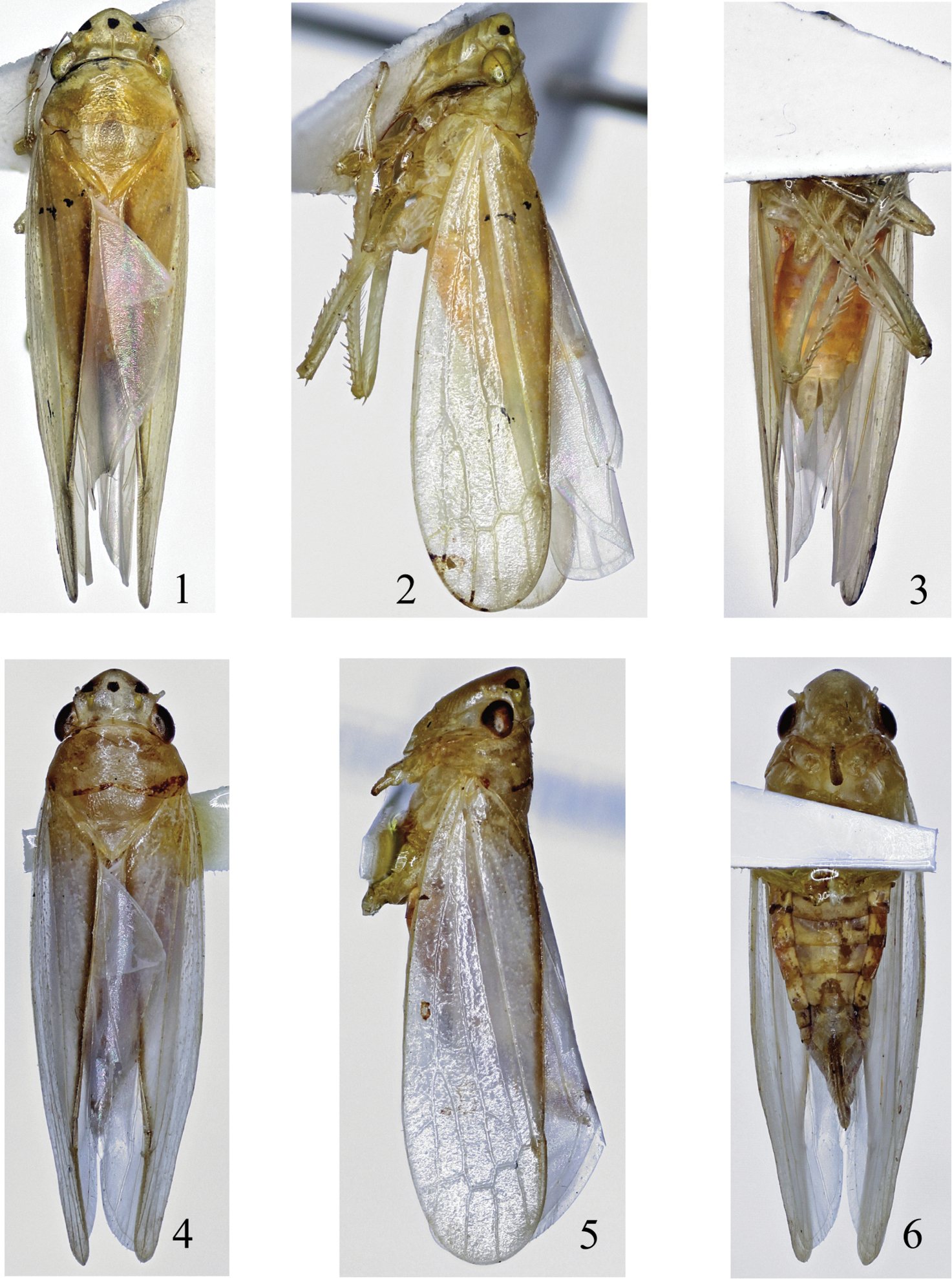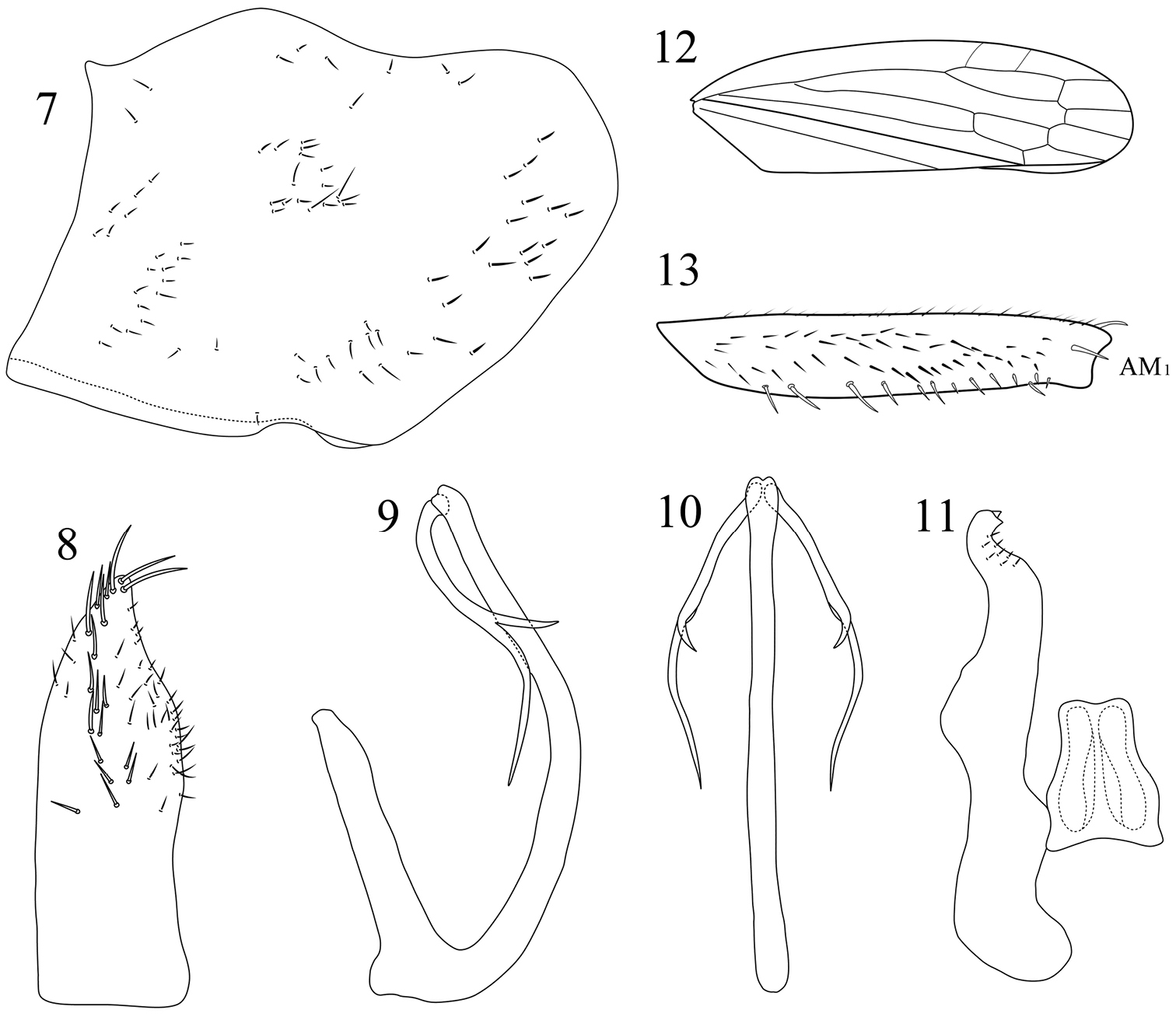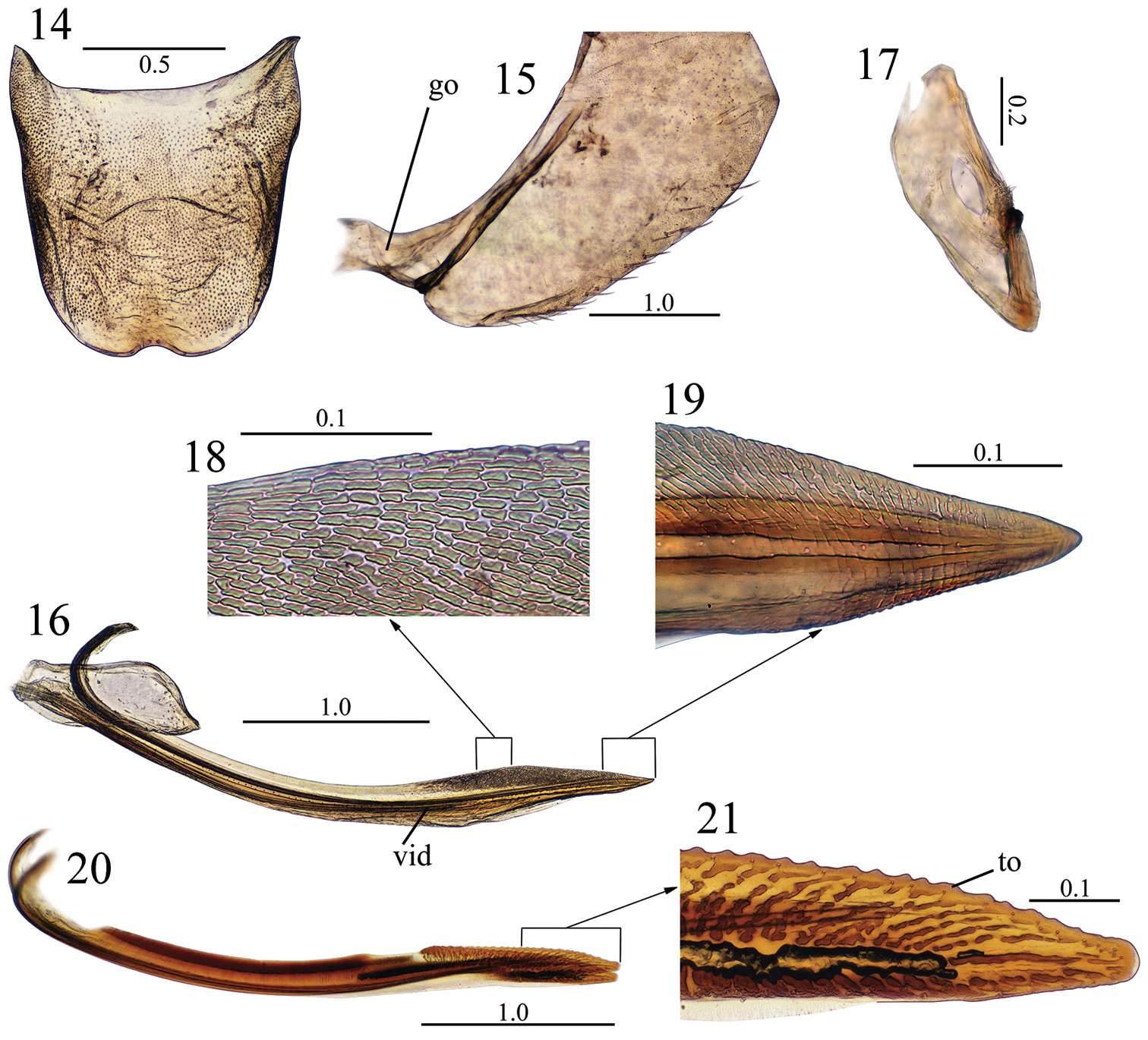






Citation: Meng Z-H, Yang M-F, Webb M (2014) Identity of the leafhopper Kolla albescens, with new synonymy (Hemiptera, Cicadellidae). ZooKeys 420: 61–68. doi: 10.3897/zookeys.420.6899
Newly collected male and female specimens of the leafhopper Kolla albescens Jacobi, 1943 from the type-locality (Northeast China), are identified as Pagaronia albescens (Jacobi), comb. n. (Evacanthinae: Pagaroniini). A redescription of the species is provided together with habitus photographs of the male and female and illustrations of the male and female genitalia. P. continentalis Anufriev, 1970 is placed as a junior synonym of P. albescens syn. n.
Auchenorrhyncha, China, new combination, Pagaroniini, taxonomy
The leafhopper Kolla albescens was described by
The male and female genital structures were prepared according to the techniques described by
Figs 1–21
“Gaolinzsy” (NE China).
Length of males 8.5–9.0 mm, females 8.7–9.8 mm.
Coloration. Male: Head, thorax and pygofer yellowish-white; apical 1/3 of crown with three transverse black spots, one at median portion and one at each lateral margin; forewing with brown costal margin; abdomen orange-yellow in ventral view, pygofer yellow-white. Female: Head, thorax and abdominal sternites yellowish-brown; forewing pale lacteous; other coloration similar to male.
Head anterior margin almost angulate; median length of crown 5/7 of interocular width; coronal suture distinct at posterior half of crown; crown concave between ocellus and coronal suture, with fovea between ocellus and eye; ocelli located in front of imaginary line between anterior eye angles, each closer to eye than to median line of crown; lateral frontal sutures extending onto crown, attaining ocelli; frons flattened medially, muscle impressions distinct in female and obscure in male; epistomal suture complete. Pronotum broader than head; anterior margin broadly rounded; posterior margin concave medially; disk transversely rugulose medially; dorsopleural carinae distinct; scutellum flattened behind transverse depression; transverse depression straight, located in middle of disk, attaining lateral margins of scutellum; forewing (Fig. 12) with base of second apical cell more proximal than base of third; medial inner subapical cell open. Fore legs with femur (Fig. 13), in anterior view, with intercalary row comprising about 10 widely spaced stout setae on distal half, first anteromedial seta (AM1) located near base of ventroapical femoral lobe, anteroventral row with about four stout setae. Hindleg with apical femoral setal formula 2:1:1. Male abdominal apodemes small, reaching near mid length of third segment.
Pagaronia albescens (Jacobi, 1943), comb. n. 1–3 body of male (9.0 mm): 1 dorsal view 2 lateral view 3 ventral view 4–6 body of female (9.8 mm) 4 dorsal view 5 lateral view 6 ventral view.
Pagaronia albescens (Jacobi, 1943), comb. n., male genitalia 7 pygofer, lateral view 8 subgenital plate, ventral view 9 aedeagus, lateral view 10 aedeagus, caudoventral view 11 connective and style, dorsal view 12 forewing 13 fore femur, anterior view. AM1 = first anteromedial seta.
Male genitalia with pygofer (Fig. 7), in lateral view, broad and strongly produced posteriorly, dorsal margin with anterior half convex and posterior half slightly concave; posterior margin broadly rounded; ventral margin with fold, fold concave near apex; disk apicoventral portion with sparse short macrosetae; microsetae also present. Subgenital plate (Fig. 8) small, distinctly shorter than pygofer; posterior area abruptly narrowed, apex nearly acute and slightly curved outwards; apical half with sparse microsetae and irregularly triseriate macrosetae medially. Aedeagus (Figs 9, 10) with long basal apodeme, as long as half of shaft; aedeagal shaft slender, curved posterodorsally, with apical aedeagal processes branched, longer branch extending beyond mid-length of shaft with short sub-branch medially. Connective shield-shaped (Fig. 11), with basal half broader. Style (Fig. 11) strong and extending posteriorly beyond connective apex, preapical portion with several microsetae; apical portion curved, S-shaped, and apex with two denticles.
Female genitalia. Sternite VII (Fig. 14), in ventral view, slightly longer than broad; posterior margin convex and with shallow concavity medially; surface with few small setae mostly on anterior half. Pygofer (Fig. 15), in lateral view, moderately produced posteriorly; posterior margin with subacute apex, dorsoposterior margin obliquely truncate; surface with macrosetae mostly on ventral margin, arranged almost in a row. Valvifers I (Fig. 16), in lateral view, longer than tall; posteroventral margin angulate. Valvifers II (Fig. 17), in lateral view, nearly fusiform, with small group of clustered setae near articulation point, articulation point located on 2/3 of dorsal margin. Valvulae relatively narrow in lateral view. Valvulae I (Fig. 16) with base subtriangular in ventral view; with convex lateral outer margin; in lateral view (Figs 16, 18, 19) with dorsal and ventral margins nearly parallel over basal two thirds behind basal curvature, thereafter slightly convex and narrowed to acute apex; dorsal sculptured area restricted to posterior 2/3 of shaft, formed mostly by subrectangular sculpture arranged in oblique lines, except basally were it is arranged horizontally; ventral sculptured area formed by dense imbricate sculpture restricted to apical portion of shaft; length of ventral interlocking device corresponding to approximately 2/3 of blade length beyond basal curvature. Valvulae II (Figs 20, 21), in lateral view, with anterior fused basal section nearly 2/3 length of blade; only slightly expanded beyond basal curvature and dorsal hyaline region; dorsal and ventral margins approximately parallel; apex narrowly rounded; preapical prominence absent; shaft bearing approximately 25 teeth (Fig. 21: to) over posterior 1/3 of blade; each tooth subtriangular; apicoventral margin without distinct teeth; teeth and dorsal margin of shaft without secondary denticles; ducts sparse, extending toward teeth and toward apical blade portion. Gonoplacs, in lateral view, expanded at apical half; apex obtuse; surface with macrosetae mostly distributed on apical portion and extending anteriorly along ventral margin of apical half.
Pagaronia albescens (Jacobi, 1943), comb. n., female genitalia: 14 sternite VII, ventral view 15 pygofer, lateral view 16 valvifer I and valvula I, lateral view 17 valvifer II, lateral view 18 dorsal sculptured area of valvula I, lateral view 19 apical portion of valvula I, lateral view 20 valvulae II, lateral view 21 apex and apical portion of valvulae II, lateral view. go = gonangulum, to = tooth, vid = ventral interlocking device. Scale bars in millimeters.
Russia, Korea, China.
3 males and 5 females, China, Liaoning Province, Henren County, Benxi Laotuding Preserve, 19 to 21 July 2011, coll. Fan Zhi-hua and Yu Xiao-fei; 1 female, China, Jilin Province, Mt. Changbai, 24 July 2011, coll. Yu Xiao-fei.
This species was described from a single female specimen (holotype) from “Gaolinzsy” (NE China). The type specimen, deposited in Deutsches Entomologisches Institut im ZALF, Müncheburg, Germany, has not been examined but our material has been compared with an image of the type (see introduction). The identity and reference for the Pagaronia species recorded from China in
Sincere thanks to Prof. Masami Hayashi (Saitama University, Japan) for giving us important information on the identity and reference for the Pagaronia species recorded in


